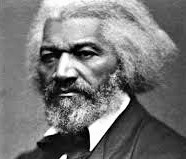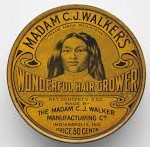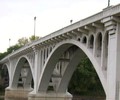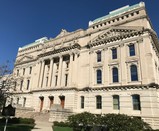
1880   Frederick Douglass spoke to a large crowd in Noblesville. The famous orator and abolitionist told his audience, “Nowhere in all my travels have I found a people so free as Americans. I find myself a citizen of the freest nation in the grandest country on the globe.” Nine years later, President Benjamin Harrison appointed Douglass to serve as Minister to Haiti.
|

1911   Madam C. J. Walker made application to incorporate a cosmetics business in Indianapolis. Her enterprise was very successful, and she became the first woman millionaire. The company had thousands of agents throughout the country engaged in selling a full line of hair products. An important part of the firm’s philosophy placed an emphasis on hygiene, appearance, and personal pride.
|
 1933   Dedication ceremonies were held for the Lincoln Memorial Bridge over the Wabash River. The span connected Vincennes to Lawrence County, Illinois. Principal speakers at the event were Indiana Governor Paul V. McNutt and Illinois Governor Henry Horner. Legend has it that the site is where Abraham Lincoln crossed the river when he moved from Indiana to Illinois. 1933   Dedication ceremonies were held for the Lincoln Memorial Bridge over the Wabash River. The span connected Vincennes to Lawrence County, Illinois. Principal speakers at the event were Indiana Governor Paul V. McNutt and Illinois Governor Henry Horner. Legend has it that the site is where Abraham Lincoln crossed the river when he moved from Indiana to Illinois. |
 1946   The first post-war Indiana State Fair presented a big show called the “Radio Roundup.” Broadcast nationwide over the ABC Radio Network, the program starred Hoagy Carmichael, Herb Shriner, Singin’ Sam, and the comedy team of Olsen and Johnson. Local talent included the Hoosier Hop Gang, the Four Notes, and Jimmy Boyer and the Rhythm Makers. Emcees were Governor Ralph Gates and Lieutenant Governor Richard James. 1946   The first post-war Indiana State Fair presented a big show called the “Radio Roundup.” Broadcast nationwide over the ABC Radio Network, the program starred Hoagy Carmichael, Herb Shriner, Singin’ Sam, and the comedy team of Olsen and Johnson. Local talent included the Hoosier Hop Gang, the Four Notes, and Jimmy Boyer and the Rhythm Makers. Emcees were Governor Ralph Gates and Lieutenant Governor Richard James. |
 1949   Civil War soldiers of the GAR (Grand Army of the Republic) held their final meeting in Indianapolis. It had been 84 years since the war ended in 1865. In attendance were 6 of the 16 surviving members of the Union Army. They ranged in age from 100 to 106. (Pictured: A GAR medal) 1949   Civil War soldiers of the GAR (Grand Army of the Republic) held their final meeting in Indianapolis. It had been 84 years since the war ended in 1865. In attendance were 6 of the 16 surviving members of the Union Army. They ranged in age from 100 to 106. (Pictured: A GAR medal) |
 1968   Roots Department Store in Terre Haute advertised the Nehru jacket, the latest style in young men’s clothing. Inspired by garments worn by the Prime Minister of India, the hip-length tailored coat was popular only for a few years in the later 1960s and early 1970s. The ones offered by Roots were made of wool with a satin lining and sold for $25. 1968   Roots Department Store in Terre Haute advertised the Nehru jacket, the latest style in young men’s clothing. Inspired by garments worn by the Prime Minister of India, the hip-length tailored coat was popular only for a few years in the later 1960s and early 1970s. The ones offered by Roots were made of wool with a satin lining and sold for $25. |
ABE MARTIN SEZ:
Why don’t the feller who says. “I’m no speechmaker,” let it go at that, instead o’ givin’ a demonstration?
– – – Kin Hubbard, The Indianapolis News, March 16, 1914
Follow this link to subscribe to Hoosier History Highlights and to view archived editions
Follow us on Instagram: @instatehousetouroffice
|





 1933   Dedication ceremonies were held for the Lincoln Memorial Bridge over the Wabash River. The span connected Vincennes to Lawrence County, Illinois. Principal speakers at the event were Indiana Governor Paul V. McNutt and Illinois Governor Henry Horner. Legend has it that the site is where Abraham Lincoln crossed the river when he moved from Indiana to Illinois.
1933   Dedication ceremonies were held for the Lincoln Memorial Bridge over the Wabash River. The span connected Vincennes to Lawrence County, Illinois. Principal speakers at the event were Indiana Governor Paul V. McNutt and Illinois Governor Henry Horner. Legend has it that the site is where Abraham Lincoln crossed the river when he moved from Indiana to Illinois. 1946   The first post-war Indiana State Fair presented a big show called the “Radio Roundup.” Broadcast nationwide over the ABC Radio Network, the program starred Hoagy Carmichael, Herb Shriner, Singin’ Sam, and the comedy team of Olsen and Johnson. Local talent included the Hoosier Hop Gang, the Four Notes, and Jimmy Boyer and the Rhythm Makers. Emcees were Governor Ralph Gates and Lieutenant Governor Richard James.
1946   The first post-war Indiana State Fair presented a big show called the “Radio Roundup.” Broadcast nationwide over the ABC Radio Network, the program starred Hoagy Carmichael, Herb Shriner, Singin’ Sam, and the comedy team of Olsen and Johnson. Local talent included the Hoosier Hop Gang, the Four Notes, and Jimmy Boyer and the Rhythm Makers. Emcees were Governor Ralph Gates and Lieutenant Governor Richard James. 1949   Civil War soldiers of the GAR (Grand Army of the Republic) held their final meeting in Indianapolis. It had been 84 years since the war ended in 1865. In attendance were 6 of the 16 surviving members of the Union Army. They ranged in age from 100 to 106. (Pictured: A GAR medal)
1949   Civil War soldiers of the GAR (Grand Army of the Republic) held their final meeting in Indianapolis. It had been 84 years since the war ended in 1865. In attendance were 6 of the 16 surviving members of the Union Army. They ranged in age from 100 to 106. (Pictured: A GAR medal) 1968   Roots Department Store in Terre Haute advertised the Nehru jacket, the latest style in young men’s clothing. Inspired by garments worn by the Prime Minister of India, the hip-length tailored coat was popular only for a few years in the later 1960s and early 1970s. The ones offered by Roots were made of wool with a satin lining and sold for $25.
1968   Roots Department Store in Terre Haute advertised the Nehru jacket, the latest style in young men’s clothing. Inspired by garments worn by the Prime Minister of India, the hip-length tailored coat was popular only for a few years in the later 1960s and early 1970s. The ones offered by Roots were made of wool with a satin lining and sold for $25.



